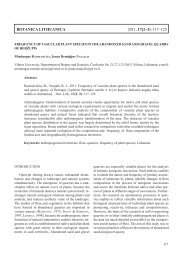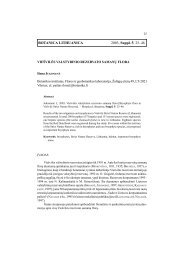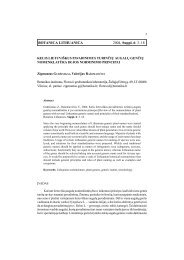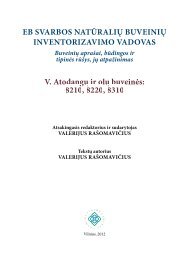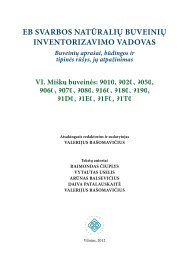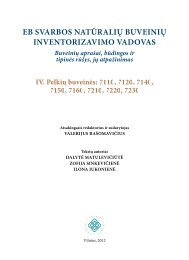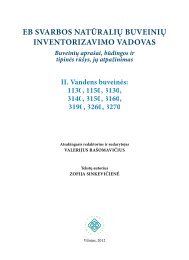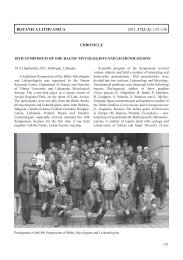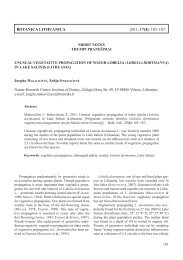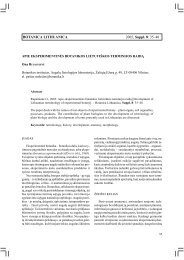FUNGI AND LICHENS IN THE BALTICS AND BEYOND XVIII ...
FUNGI AND LICHENS IN THE BALTICS AND BEYOND XVIII ...
FUNGI AND LICHENS IN THE BALTICS AND BEYOND XVIII ...
You also want an ePaper? Increase the reach of your titles
YUMPU automatically turns print PDFs into web optimized ePapers that Google loves.
LICHENOLOGY<br />
POST-FIRE RECOVERY OF <strong>THE</strong> LICHEN COVER <strong>IN</strong> A WEST SIBERIAN<br />
FOREST: ZONAL ASPECTS<br />
S. ABDULMANOVA<br />
Institute of Plant and Animal Ecology, Ural Division of RAS, 8th March Str. 202, 620144<br />
Yekaterinburg, Russia<br />
E-mail: svabdulmanova@e1.ru<br />
Regular fires have significant influence on tundra and taiga ecosystems. Features of<br />
vegetation recovery in these territories are determined by climatic conditions and degree of<br />
disturbance. We sought to assess impacts of fire on lichen communities in West Siberia,<br />
Russia.<br />
The goal of our study is to present an original assessment of lichen cover during postfire<br />
recovery in latitudinal gradient from forest-tundra to taiga zones.<br />
Key plots were located into post-fire community of tundra and forest sites in foresttundra<br />
zone and also in three subzones of taiga: northern light forest, middle and southern<br />
boreal forests. We sampled a total of 76 plots with a 100 m 2 size.<br />
We had several primary trends in this study: a) species diversity and richness of postfire<br />
lichen communities in different zones; b) analysis of ecological and geographical<br />
structure of biota throughout succession stage; c) indicator species of post-fire communities;<br />
d) dynamics of lichen mat structure and phytomass.<br />
Lichen mat conditions and successional status of different stages of post-fire recovery<br />
into study zones were indicated using occurrence, abundance, total and average cover of both<br />
individual species and their morphological groups. Indicator species for uneven-aged<br />
pyrogenic communities and four stages of post-fire lichen cover were defined from analysis of<br />
these parameters. Differences of height, age and growth of Cladonia species confirmed<br />
validity of defining stages.<br />
Biomass of lichen mat and its structure in multiple-aged stage post-fire communities<br />
depended on zonal conditions of study areas and dynamics of other parameters which<br />
characterized lichen cover.<br />
<strong>LICHENS</strong> <strong>AND</strong> LICHENICOLOUS <strong>FUNGI</strong> ON ST<strong>AND</strong><strong>IN</strong>G ‘DEAD WOOD’<br />
<strong>IN</strong> POLISH WESTERN CARPATHIANS<br />
P. CZARNOTA<br />
Department of Agroecology and Landscape Architecture, University of Rzeszów,<br />
Ćwiklińskiej 2, PL-35-601 Rzeszów, Poland<br />
E-mail: pawczarnota@poczta.onet.pl<br />
Three mountain ranges of Polish Western Carpathians (Gorce Mts, Babia Góra Massif<br />
and Tatra Mts) were explored in the period 2008–2010 to investigate the diversity of<br />
lichenized and lichenicolous fungi occupying dead spruce trees and snags in natural forests<br />
destroyed by bark beetle Ips typographus. 400 objects in strictly protected areas of national<br />
parks have been studied, representing the type of simple, group and large-scale destruction of<br />
stands. 161 species of fungi (144 on wood and 101 on bark remnants) were found; 140<br />
lichenized, 20 lichenicolous and commonly occurring non-lichenized Mycocalicium subtile.



